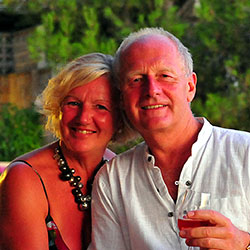On a road to nowhere, there’s nowhere more pleasant in India than this Queen of the Central Highlands.
Set atop a 12sq mile plateau in the heart of India on a road to nowhere, Pachmarhi, in the central state of Madhya Pradesh has to be one of the most beautifully preserved examples of Indian rural life and colonial heritage.
First ‘discovered’ in 1857 by Captain James Forsyth of the British Army, Pachmarhi, although historically territory of the tribal Gonds, soon became the summer hill capital for the British in the Central Provinces.

This beautiful Jacaranda tree in full bloom illustrates the very formal nature of earlier colonial planting on a plateau that is otherwise still largely left to nature
With the withdrawal of British Forces from India in 1947, control of the plateau ceded to the Indian Army who maintain a base there to this day. It is this presence that has singularly assisted in keeping the original infrastructure so beautifully preserved, compared with other locations in India.
Many of India’s heritage locations have suffered from the inexorable ‘creep’, if not flood, of cheap featureless concrete development accompanied by burgeoning population numbers – not so Pachmarhi.

The sparsely populated nature of the plateau illustrated by the smattering of old colonial buildings, as seen from the top of Pachmarhi Hill
Development on the plateau has been restricted to the original Bazaar area primarily and the old colonial buildings out on the plateau have now been preserved and refurbished to form hotels and lodges for tourists.
Population barely exceeds 10,000 in total, many of whom are smart, well behaved army personnel who keep themselves to themselves.
The army ‘cantonment’ and residential areas, however, only occupy about fifteen percent of the total plateau area, with the remainder still devoted to woodland and grassland that spills over the edges of the hilltop into some of the most stunning gorges, ravines and jungle in India – that of Satpura National Park.

We’ll cover Satpura in a later article but Pachmarhi is well worth a visit in its own right.
Getting to Pachmarhi can be a bit of a mission but the effort is amply rewarding. It’s best located on a map of India by drawing north/south and east/west datum lines to bisect the country. Where they cross is roughly where Pachmarhi is situated.
If you haven’t arranged your own private a/c car and driver as part of a larger tour, then you can either disembark from the Mumbai-Howrah Express at Pipariya railway station and catch a taxi for a hair-raising 30 minute ride up the ghat, or catch the regular M.P.Tourism bus from Bhopal direct to Pachmarhi, which takes about four and a half hours.

Vehicles occasionally fall off the road!
Your introduction to Pachmarhi will be on the steady climb from Matkuli Village, at the base of the plateau, after crossing the River Denwa that gradually transforms from a practically dry river-bed growing squashes until May, to a raging torrent of boiling water that can cut off the plateau by burying its low bridge during July and August.
The climb becomes increasingly steep and winding, with rural hamlets, medieval irrigation systems, fields of wheat and grazing buffalo giving way to rocky hillsides heavily covered by Sal trees with their lush green leaves. As you near the summit at over 1,100 metres (approx. 3,580 ft) you notice a freshening of the air and a welcome slight drop in temperature that renders Pachmarhi an idyllic place to stay at any time of year (except during the monsoons when an enduring wall of grey water obliterates any desire to remain).
The bus, or your taxi, arrive at the ‘bus stand’ where you’ll alight and wonder what all the fuss is about; as you’re confronted by another gathering of yells and bells in a featureless car park surrounded by the usual selection of concrete boxes doubling as stalls.
Don’t lose heart! Plan ‘A’ should always be to have arranged your accommodation outside of the bazaar if you’re more interested in nature, wildlife and peace and quiet.
The bazaar is worth a visit for its market, stalls and trades – and there are numerous Indian hotels within its grid of roads – but you are here to embrace what Pachmarhi has that is unique, so you need to get out onto the plateau at first opportunity.
Its a rural way of life intermingled with a whiff of sophistication that epitomises Pachmarhi’s character; demonstrated by the local villagers, their artisan skills and daily practices and the more commercial pursuits of shopkeepers, all mixed with the smart official and private colonial-style residences.
There is a limited range of accommodation on the plateau, from ‘homestays’, such as the esoteric ‘Evelyn’s Own’ run by our great friends Colonel and Mrs Rao to the more formal ‘Rock End Manor’ run by M.P. Tourism and WelcomHeritage Golf View.
All offer attractive accommodation in quaint heritage buildings with authentic service that isn’t always what a seasoned international traveller might expect, who prefers fawning efficiency, but is nevertheless always well-meaning and friendly.
Situated at the dead end of a road that only leads to the plateau, ensures that unlike many other hill stations it isn’t shaken and disturbed by endless convoys of lorries and traffic heading somewhere else – so the only people who visit Pachmarhi are those who want to be there.
For much of the year this will be Indian honeymoon couples who can often be seen mooning around the plateau. If your interests lie elsewhere then you could easily spend a week on and around the plateau, simply exploring some of the stunning scenery, geological features or holy shrines.
Forays to Dhupgarh (the highest point of the Satpuras) can leave you breathless, especially if you’ve walked to the peak but more so from the panoramic vista of Satpura National Park that stretches before you like a verdant afforested land that time has forgotten.
If you get the timing right (sunrise is less well attended than sunset, especially by honeymooners) then Dhupgarh can embrace you in tranquility and peace as you gaze across the wilderness before you. That said, many of the secluded areas around the plateau offer fascinating views of ravines, waterfalls and caverns where you might be the only visitor if you don’t go at the most popular times.
The more accessible areas, such as Pandav Caves and the central plateau area can be less restful if parties of tourists choose to yell and catcall to one another.
Don’t be deterred from a visit to Pachmarhi. From soaring vultures, to hundreds of colourful Kingfishers, Parakeets, Robins and Blue Jays; from the secretive wild leopard to ambling domestic buffalo; vividly coloured shrines to mud coloured huts; Victorian bungalows with flowering formal gardens; man-made lakes to nature’s cascades; you’ll not only love Pachmarhi but will have been one of the few visitors in India to find this haven of escape from the noise, pollution and constant attention of hawkers, so often associated with the wonders that this continent has to offer.
It’s easy to rent one of the many jeeps that ply the plateau but make sure you get the itinerary you want and discuss the quietest times to visit places – or you can simply head off for a walk with a local map as most places on the plateau are within easy reach during the course of a day. Do remember to take refreshment with you if you do go for the day, unless you only drink Cola and eat crisps, which are the ubiquitous fare at most roadside stalls.

The local map, charmingly, has changed little from the Pachmarhi Guide Map shown above that was published by Survey of India in 1925 – Happy exploring!
If you’ll forgive the alliteration –You’ll become passionate about the possibilities when you pause peacefully in pleasant Pachmarhi!


If you simply want more information about this wonderful area of India then follow the link here – or why not ask us to arrange your own tailor-made travel throughout India – see below.
Here are links to the accommodation mentioned in our article:
Evelyn’s Own Homestay – Link to Facebook profile
Rock End Manor M.P.Tourism Hotel website
WelcomHeritage Golf View Website

 Let us plan your own inspiring journey to Pachmarhi and throughout India
Let us plan your own inspiring journey to Pachmarhi and throughout India
Why not download the TLC World guide brochure or give us a call today on 01202 030443, or simply click ‘enquire’ to submit your own personal itinerary request































